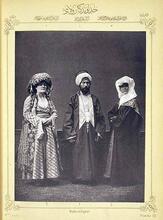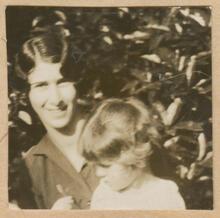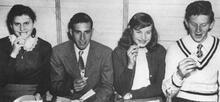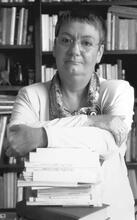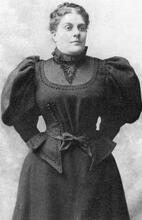Women's American ORT
ORT (the Organization for Rehabilitation through Training) was founded in Russia in the late nineteenth century and opened its American, all-male organization in 1922. Women, mostly wives of male ORT members, became involved in the organization five years later, founding a women’s auxiliary group (WAO). Women fundraised for the social work of ORT through the first decades of the twentieth century, reflecting Jewish women’s expanding role in public life. As the Nazis took power in Germany, WAO helped impoverished Jews in Europe and shifted their efforts towards aid for displaced persons. Much of its work focused on creating vocational and technical schools across the world. In the later twentieth century, WAO expanded to help create medical services for students and provide recreational facilities, among many other tasks.
The Founding of ORT
ORT (initials of Russian Obshchestvo Rasprostraneniya Truda Sredi Yevreyev), the Organization for Rehabilitation through Training, was founded in Russia in 1880 to promote vocational training of trades and agriculture among impoverished Jews. Craftsmen received aid to move from the Pale of Settlement to the Russian interior and to establish small trades workshops, trade schools, and vocational courses. ORT gradually expanded to create Jewish agricultural colonies, model farms, and agricultural schools. During World War I, ORT helped Jewish refugees resettle and find employment. After the 1917 Revolution, ORT helped Jewish farmers and craftsmen in Russia, the Ukraine, Belorussia, Bessarabia, and elsewhere in the Soviet Union.
In 1921, ORT was established in Berlin as an international organization, the World ORT Union, which quickly became active throughout Poland, Lithuania, Latvia, Bessarabia, Germany, France, Bulgaria, Hungary, and Romania. ORT spread the idea of manual work among Jews and stressed the need for a change in the economic structure of Jewish life. ORT organizations were established in the United States, South Africa, Canada, South America, and elsewhere.
American ORT was founded as a males-only organization in 1922, when a program of activities and financing was agreed upon with the Joint Distribution Committee. The new organization was supported by the Workmen’s Circle, followed by large sections of the Jewish labor movement. This initial response proved critical to the development of ORT and Women’s American ORT as broad-based community organizations.
Women’s American ORT
Women’s American ORT (WAO) was founded October 12, 1927, to assist ORT in providing financial support to the ORT program serving Eastern European Jews. Most of the founders were wives of ORT leaders: Florence Dolowitz was the wife of the treasurer of American ORT; Anna Boudin was the wife of lawyer Louis Boudin, who was also vice president of American ORT. Their marital connections were critical factors in creating an auxiliary organization to assist their husbands’ work.
The women’s early support for ORT was limited to bazaars and concerts spearheaded by the wives of ORT leaders and their friends, led by Fannie Shluger and Mrs. Jacob Panken. A glamorous recital by Efram Zimbalist at Carnegie Hall in 1928 to help the Jews in Eastern Europe launched their activities as a women’s auxiliary. The concert program listed as patrons some of the leading American Jewish women of German origin. Supporters also included Eastern European Jewish wives and leaders of the International Ladies Garment Workers Union, reflecting the close support between the labor movement and ORT that would continue throughout its history.
In its first years, the women helped raise funds for the ORT Reconstruction Committee, designed to help Eastern Europe’s Jews recover from World War I. Only one woman sat on the ORT National Committee at that time: Louise C. Taussie.
Women’s support of ORT reflected Jewish women’s emergence into public life by creating their own organizations to meet community needs. After World War I, some women were becoming increasingly independent due to their service in the war and activism in such causes as obtaining votes for women. Many middle-class women, however, remained cautious about public activism and preferred to put their energies into more traditional social service. Although a few Jewish women’s organizations, such as the National Council of Jewish Women, were independent of men in the 1930s, many remained as auxiliaries. WAO, still a brand-new organization of women finding its way, fit that pattern of social service in connection to larger, male-run groups.
By 1933, the women’s auxiliary was large enough to put on a pageant, Activities of ORT, at the 44th Street Theater in New York City, demonstrating the various skills taught by ORT in different countries. A year later, the women raised money to rescue six hundred workshops in Poland that trained five thousand workers. Women’s ORT soon branched out beyond Manhattan to Long Island, and then to other cities, from San Antonio to Chicago.
The pioneers were not content to limit their organizing efforts to the United States. A Women’s ORT was organized in Poland in 1935, launched by Anna and Louis Boudin, leaders of women’s and men’s American ORT. WAO increased its assistance to Jews in Poland as their intense poverty worsened in the years before the Nazi invasion.
By 1937, as war became imminent, WAO raised funds for the relief of German refugees and intensified its efforts for Polish Jewish workers. WAO created study groups to educate women on the situation in Eastern Europe. WAO strongly supported ORT’s work in Germany and Eastern Europe, as it precariously maintained training schools after the Nazi Anschluss and invasion of Poland in 1938. During this period in Germany, for example, ORT opened a vocational high school in Berlin that survived until 1943.
At this critical juncture, WAO’s prestigious honorary chairwoman, Mrs. Albert Einstein, died. Her loss made it harder to fulfill WAO’s 1938 pledge to raise fifty thousand dollars, but they met their goal. In doing so, WAO established itself as a vital element in the survival of the World ORT Union at an especially perilous time in its history. Einstein’s place remained vacant until 1950, when the Baroness Pierre de Gunzbourg became WAO’s honorary national president, remaining in that post until her death in 1969.
World War II
As war neared in 1940, Women’s American ORT was created as an independent organization at ORT’s first annual convention in thirteen years, with the theme “A Trade is a Refugee’s Passport.” WAO was no longer content to remain a women’s auxiliary to men. Their fund-raising prowess and critical influence in ORT affairs had apparently convinced the women that they had the skills and experience to act independently. The urgent need to raise money for imperiled European Jews who were now less able to raise funds themselves appears to have compounded their belief that they needed to act quickly. This demanded independence from men’s American ORT, caught up in the multitude of contrasting demands from their members, clients, and supporters. Above all, they were guided by the example of other Jewish women’s organizations, such as the National Council of Jewish Women, which were tackling refugee problems with vigor and distinction.
As the Germans conquered Europe, WAO funded ORT accommodations for refugees in various ORT installations in France, vocational courses in Swiss camps and internment homes, and maintenance of ORT workshops in Polish ghettos that managed to be kept alive until the ghettos were destroyed.
By the end of the war, ORT had transformed itself into an emergency organization primarily serving adult displaced persons (DPs) about to migrate or in transit. WAO was a vital element in funding ORT’s postwar vocational training in the DP camps, as well as the rehabilitation of DPs in the United States, Israel, Holland, Belgium, Greece, and elsewhere in free Europe. In Israel, WAO was particularly instrumental in establishing vocational and agricultural schools for refugees. In the process, WAO leaders became skilled in fund-raising for postwar needs.
A New Era
By 1950, Women’s American ORT’s membership had climbed to more than twelve thousand, and the organization had become a financial mainstay of the World ORT Union. Among all World ORT Union members, “By far the most spectacular expansion was registered by Women’s American ORT,” notes Jack Rader in ORT’s official history.
Women of the 1950s who had worked or run wartime volunteer efforts returned to the home as men returned from the war. Still, these women had acquired skills during wartime that they did not wish to abandon in peacetime. Volunteerism filled that gap, as it had for women after World War I.
By the mid-1950s, WAO was helping to fund ORT’s growing network of vocational and technical high schools in Western Europe and North Africa, Iran, India, and Israel. Technical schools and schools for special needs were established across the developing countries as well.
WAO boasted of a “distinctive and unique role” in world Jewish life by 1958. It funded scholarships for teacher training, social assistance to needy students, preventive medical care, maintenance of vocational training schools, and support of Tel Aviv’s Aaron Syngalowski Center. It also helped fund the establishment of a network of large ORT apprentice training centers throughout Israel.
The need to educate American Jewish communities so they could raise money for refugees propelled WAO into a new position in American life. WAO immersed itself in American Jewish life, spreading the ORT message in several ways. Viewing the education of American communities about ORT as part of its mission, it produced public programs and study groups. WAO reinforced its image and influence by supporting the major Jewish fund-raising campaigns: United Jewish Appeal, local welfare funds, and Israel Bonds. Its Americanization of ORT became a critical factor in WAO’s membership growth and its growing power within the World ORT Union.
WAO also generously contributed to the Joint Distribution Committee’s budget, increasing the effect of its financial support to the overseas operations of the world ORT Union.
WAO took care to infuse new meaning to the personal lives of WAO members. Understanding that its growth as a membership organization depended on its appeal to women, WAO provided programs that linked education and social activity. Combining informal meetings, classes, and casual and glamorous social functions made the organization more attractive and fulfilling to women living in the suburbs of the 1950s who wanted to make congenial friendships as well as to fund a social cause.
Adapting for the Future
The tactics succeeded. By 1970, Women’s American ORT boasted nearly ninety thousand members organized into seven hundred chapters across the United States. Educating communities about ORT’s purpose, WAO brought ORT into every substantial community across the United States, rooting ORT into American Jewish communal life as never before.
WAO was now the World ORT Union’s central financial backbone, contributing almost $2 million annually. From the postwar years to 1970, it provided over $15 million to the parent organization, an astonishing sum raised through membership activities alone. WAO remains the World ORT Union’s largest affiliate organization, with a WAO representative serving on the union’s executive committee.
Continuing to fund ORT’s basic projects, WAO expanded its aid into programs of accelerated adult training; scholarships for teacher training; medical and health services to students; apprenticeship; social assistance to help provide meals, clothing, cultural and recreational facilities; and school construction and equipment.
But the women’s movement has changed the way American women approach volunteerism. As more and more women moved out of the home and into careers, WAO found it necessary to change its membership tactics as well. The results influence the organization’s methods and approach. Like other women’s groups, WAO must appeal to growing numbers of young career women, either single women or young mothers juggling jobs and childcare. Programs include fewer luncheons and more evening meetings, and fund-raising causes focus not only on vocational needs abroad but also on issues at home in America: public education, literacy, combating antisemitism, and support for women’s rights.
Facing the threat of declining membership that affects all volunteer women’s organizations, WAO is attempting to adapt to the needs and constraints of working women by developing special chapters that appeal to single women and young mothers. WAO also focuses on issues of concern to women, such as a conference on the genetics of breast cancer. It participates in the campaign to stop domestic abuse by the Conference of National Jewish Women’s Organizations. WAO takes positions supporting women’s equality, as well as freedom from harassment and physical and mental abuse.
Attempting the difficult task of engaging busy young women, WAO is devoting more staff on working with this group of women. Programs are being designed to enrich their personal lives. At the same time, WAO is cultivating young leadership, involving them intellectually, socially, and financially in the organization’s goals. The effort is meeting with some success. The president’s Young Leadership Council involves a core of young women who are making a significant impact and revitalizing Women’s American ORT to meet the needs of today’s women.
Even the approach to technical education has expanded to reflect younger members’ interests. The Bramson ORT Technical Institute in Queens, New York, opened in the 1970s, not only provides vocational education but also hosts broader educational projects, such as a conference for educators from Jewish educational institutions. WAO has also opened schools in Los Angeles, New York, and Chicago, where it has a two-year program for adults that teaches English as a second language, computers, and robotics to refugees and American citizens. These schools operate independently, supported by WAO and its member-volunteers. WAO also operates programs in Jewish day schools in Atlanta and Miami.
In 2007, American ORT and Women’s American ORT merged to create ORT America, which is affiliated with World ORT.
Abramson, Rosina K. “The Millennium Is Only Three Years Away” (unpublished speech).
EJ 12: 1482–1486.
Focus: The Women’s American ORT Leadership Newsletter.
Kaufman, Mrs. Ferdinand. History of Women’s American ORT: From Auxiliary to Movement.
ORT Reporter.
Rader, Jack. By the Skill of Their Hands: The Story of ORT.
Women’s American ORT. QuORTerly Briefing: Issues and Trends.



